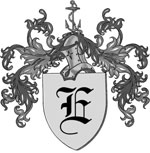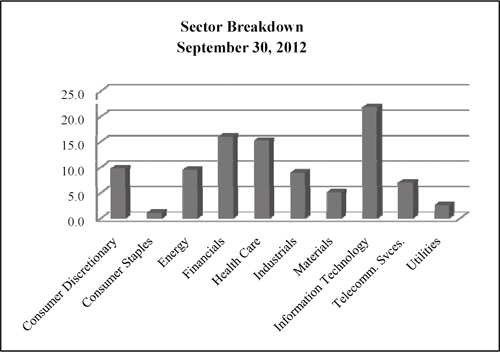2.
The Funds generally will support proposals to de-classify boards of directors if fewer than 66 2/3% of the directors are independent, and will generally vote against proposals to classify boards of directors.
3.
The Funds generally will withhold a vote in favor of a director who has served on a committee which has approved excessive compensation arrangements or proposed equity-based compensation plans that unduly dilute the ownership interests of stockholders.
1.
The Funds generally will vote in favor of independent accountants approved by an issuer. Prior to such vote, however, Dinsmore will take into consideration whether non-audit fees make up more than 50 to 75% of the total fees paid by such issuer to the independent auditors, and the nature of the non-audit services provided.
1.
Except as provided in Section E.1, as a general rule, the Funds will vote against proposals recommended by management of a company that are being made primarily to implement anti-takeover measures, and will vote in favor of proposals to eliminate policies that are primarily intended to act as anti-takeover measures.
2.
Subject to the other provisions of these guidelines, including without limitation provision C.1. above, the Funds generally will vote in accordance with management’s recommendations regarding routine matters, including the following:
a.
b.
c.
Change of state of incorporation for specific corporate purposes.
1.
The Fund generally will vote in favor of broad-based stock option plans for executives, employees or directors which would not increase the aggregate number of shares of stock available for grant under all currently active plans to over 10% of the total number of shares outstanding.
2.
The Funds generally will vote in favor of employee stock purchase plans and employee stock ownership plans permitting purchase of company stock at 85% or more of fair market value.
1.
Contested situations will be evaluated on a case by case basis by the portfolio manager or analyst at Dinsmore principally responsible for the particular portfolio security.
2.
The Funds may, in their discretion, abstain from voting shares that have been recently sold.
3.
The Funds generally will abstain from voting on issues relating to social and/or political responsibility.
4.
Proposals that are not covered by the above-stated guidelines will be evaluated on a case by case basis by the portfolio manager or analyst at Dinsmore principally responsible for the particular portfolio security.
F.
Material Conflicts of Interest
1.
Conflicts of interest may arise from time to time between Dinsmore and the Funds. Examples of conflicts of interests include:
a.
Dinsmore may manage a pension plan, administer employee benefit plans, or provide services to a company whose management is soliciting proxies;
b.
Dinsmore or its officers or directors may have a business or personal relationship with corporate directors, candidates for directorships, or participants in proxy contests;
c.
Dinsmore may hold a position in a security contrary to shareholder interests.
2.
If a conflict of interest arises with respect to a proxy voting matter, the portfolio manager will promptly notify the Funds’ Audit Committee and counsel for independent trustees and the proxies will be voted in accordance with direction received from the Audit Committee.
G.
Amendments
1.
Any proposed material amendment to these Guidelines shall be submitted for review and approval to:
a.
the Funds’ Board of Trustees, including a majority of the disinterested trustees; and
b.
the Adviser’s Board of Directors.
2.
Non-material amendments to these Guidelines may be made by the Chair of the Funds, upon consultation with counsel to the Funds and the Funds’ Chief Compliance Officer, and will be reported to the Funds’ Board of Trustees at their next scheduled in-person meeting.
ITEM 8. PORTFOLIO MANAGERS OF CLOSED-END MANAGEMENT INVESTMENT COMPANIES.
(a) (1) As of December 7, 2012, Mr. Thomas H. Dinsmore, Chairman and Chief Executive Officer, Ms. Jane D. O’Keeffe, President, and Mr. James A. Dinsmore, Vice President, comprise the three-person portfolio management team of the Fund. Mr. Thomas H. Dinsmore has served as portfolio manager since 1996. Ms. O’Keeffe and Mr. James Dinsmore became co-portfolio managers on January 1, 2011. Mr. Thomas H. Dinsmore is the lead member of the portfolio management team.
Since 1994, Ms. O’Keeffe has served as President of the Fund and of Dinsmore Capital (the “Advisor”), as well as Managing Director of Research for the Advisor. Mr. James A. Dinsmore has served as Vice President of the Fund and of the Advisor since 2007 and also has been a research analyst for the Advisor since 2004.
Messrs. Thomas H. Dinsmore and James A. Dinsmore and Ms. O’Keeffe receive investment recommendations from a team of research analysts prior to making investment decisions about transactions in the portfolio. Generally, the co-portfolio managers make decisions jointly about any transactions in the Fund’s portfolio, but each co-portfolio manager may do so independently as well.
(2) The portfolio management team comprised of Mr. Thomas H. Dinsmore, Ms. Jane D. O’Keeffe and Mr. James A. Dinsmore is also primarily responsible for the day-to-day management of one registered investment company, Bancroft Fund Ltd. (“Bancroft”), with total assets of $103,050,010 as of November 30, 2012. The portfolio management team does not manage any accounts or assets with performance-based advisory fees. Mr. Thomas Dinsmore is Chairman and Chief Executive Officer, Ms. O’Keeffe is President and Mr. James Dinsmore is Vice President of Bancroft. This information is as of December 7, 2012. The Fund and Bancroft have similar investment objectives and strategies. As a result, material conflicts of interest may arise between the two funds if a security is not available in a sufficient amount to fill open
orders for both funds. To deal with these situations, the investment adviser for the Fund and Bancroft has adopted Trade Allocation Procedures (the “Allocation Procedures”). The Allocation Procedures set forth a method to allocate a partially filled order among the funds. Pursuant to the method, the amount of shares that each fund purchases is allocated pro rata based on the dollar amount of each fund’s intended trade or, if the order is subject to a minimum lot size, as closely as possibly to such an allocation.
The Allocation Procedures permit Dinsmore Capital to allocate an order in a way that is different from the method set forth above if (i) each fund is treated fairly and equitably and neither fund is given preferential treatment, and (ii) the allocation is reviewed by the chief compliance officer of Dinsmore Capital.
(3) This information is as of December 7, 2012. The Portfolio Management team is compensated by Dinsmore Capital through a three-component plan, consisting of a fixed base salary, annual cash bonus, and benefit retirement plan. Their compensation is reviewed and approved by Dinsmore Capital’s Board of Directors annually. Their compensation may be adjusted from year to year based on the perception of Dinsmore Capital’s Board of Directors of the team’s overall performance and their management responsibilities. Their compensation is not based on (i) a formula specifically tied to the performance of the Fund or Bancroft, including performance against an index or (ii) the value of assets held in the Fund’s portfolio.
(4) As of December 7, 2012, Mr. Thomas Dinsmore’s beneficial ownership in the Fund’s shares was in the range of $100,001-$500,000. Ms. O’Keeffe’s beneficial ownership in the Fund’s shares was also in the range of $100,001-$500,000. Mr. James Dinsmore’s beneficial ownership in the Fund’s shares was in the range of $10,001-$50,000.
ITEM 9. PURCHASES OF EQUITY SECURITIES BY CLOSED-END MANAGEMENT INVESTMENT COMPANY AND AFFILIATED PURCHASERS.
During the period covered by this report, there were no purchases made by or on behalf of the Fund or any “affiliated purchaser,” as defined in Rule 10b-18(a)(3) under the Exchange Act (17 CFR 240.10b-18(a)(3)), of shares or other units of any class of the Fund’s equity securities registered by the Fund pursuant to Section 12 of the Exchange Act (15 U.S.C. 781).
ITEM 10. SUBMISSION OF MATTERS TO A VOTE OF SECURITY HOLDERS.
There have been no material changes to the procedures by which shareholders may recommend nominees to the Fund’s Board of Trustees since those procedures were last disclosed in response to the requirements of Item 407(c)(2)(iv) of Regulation S-K (17 CFR 229.407) (as required by Item 22(b)(15) of Schedule 14A (17 CFR 240.14a-101)), or Item 10 of this Form N-CSR.
ITEM 11. CONTROLS AND PROCEDURES.
Conclusions of principal officers concerning the effectiveness of controls and procedures:
(a) As of December 7, 2012, an evaluation was performed under the supervision and with the participation of the officers of the Fund, including the PEO and the PFO, to assess the effectiveness of the Fund’s disclosure controls and procedures, as that term is defined in Rule 30a-3(c) (17 CFR 270.30a-3(c)) under the Investment Company Act of 1940, as amended (the “Act”). Based on that evaluation, as required by Rule 30a-3(b) under the Act (17 CFR 270.30a-3(b)) and Rules 13a-15(b) or 15d-15(b) under the Exchange Act (17 CFR 240.13a-15(b) or 240.15d-15(b)), the Fund’s officers, including the PEO and PFO, concluded that, as of December 7, 2012, the Fund’s disclosure controls and procedures were reasonably designed so as to ensure: (1) that information required to be disclosed by the Fund on Form N-CSR is recorded, processed, summarized and reported within the time periods specified by the rules and forms of the Securities and Exchange Commission and (2) that material information relating to the Fund is made known to the PEO and PFO as appropriate to allow timely decisions regarding required disclosure.
(b) There have been no changes in the Fund’s internal control over financial reporting (as defined in Rule 30a-3(d) under the Act (17 CFR 270.30a-3(d)) that occurred during the second fiscal quarter of the period
covered by this report that has materially affected, or is reasonably likely to materially affect, the Fund’s internal control over financial reporting.
ITEM 12. EXHIBITS.
(a)(1) Not applicable. See the Fund’s response to Item 2, above.
(a)(2) Certifications of the principal executive officer and the principal financial officer pursuant to Rule 30a-2(a) under the Act (17 CFR 270.30a-2(a)), are attached hereto.
(a)(3) There were no written solicitations to purchase securities under Rule 23c-1 under the Act (17 CFR 270.23c-1) sent or given during the period covered by the report by or on behalf of the Fund to ten or more persons.
(b) Certifications of the principal executive officer and the principal financial officer, as required by Rule 30a-2(b) under the Act (17 CFR 270.30a-2(b)), Rule 13a-14(b) or Rule 15d-14(b) under the Exchange Act (17 CFR 240.13a-14(b) or 240.15d-14(b)), and Section 1350 of Chapter 63 of Title 18 of the United States Code (18 U.S.C. 1350) are attached hereto.
SIGNATURES
Pursuant to the requirements of the Securities Exchange Act of 1934 and the Investment Company Act of 1940, the registrant has duly caused this report to be signed on its behalf by the undersigned, thereunto duly authorized.
Ellsworth Fund Ltd.
By: /s/ Thomas H. Dinsmore
Thomas H. Dinsmore
Chairman of the Board and
Chief Executive Officer
(Principal Executive Officer)
Date: December 7, 2012
Pursuant to the requirements of the Securities Exchange Act of 1934 and the Investment Company Act of 1940, this report has been signed below by the following persons on behalf of the registrant and in the capacities and on the dates indicated.
By: /s/ Thomas H. Dinsmore
Thomas H. Dinsmore
Chairman of the Board and
Chief Executive Officer
(Principal Executive Officer)
Date: December 7, 2012
By: /s/ Gary I. Levine
Gary I. Levine
Chief Financial Officer
(Principal Financial Officer)
Date: December 7, 2012



